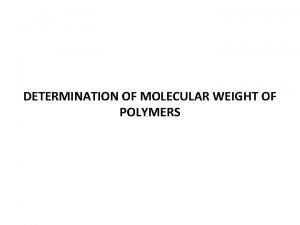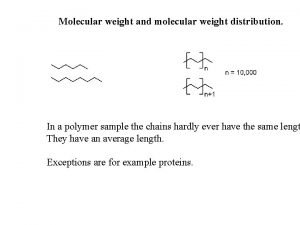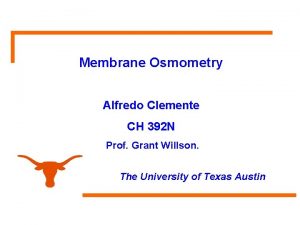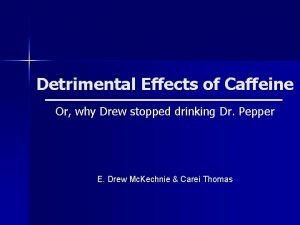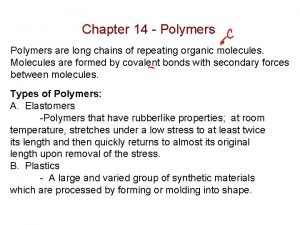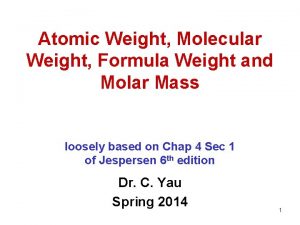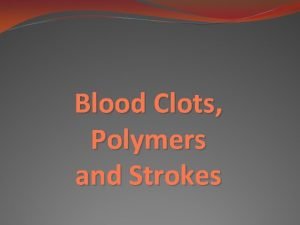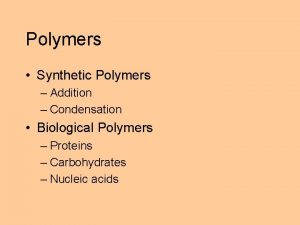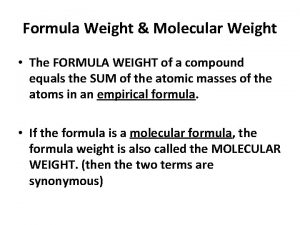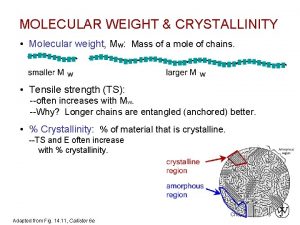Foundation GPC Part 1 Polymers and Molecular Weight

















- Slides: 17

Foundation GPC Part 1 – Polymers and Molecular Weight

Introduction § This presentation introduces polymers and what is meant by molecular weight § The nature of polymers shall be discussed, along with some examples of common materials § The meaning of molecular weight shall be introduced § The term molecular weight distribution shall be introduced 2

What are Polymers? § Polymers are long chain molecules produced by linking small repeat units (monomers) together § There are many ways to link different types of monomer to form polymers § Polymers exhibit very different physical properties compared to the monomers, dependent on the length of the polymer chains § The presence of small amounts of very long or very short chains can have drastic effects on properties of the material 3

Variations in Polymers They can be varied in lots of ways, for example; § Chemical Structure of Monomer Unit § 3 D Structure § Different Monomer Units § Length of polymer chains § Distribution of polymer chain lengths 4

Example - Nitrocellulose § First synthetic polymer made in the 1890’s § Hard, strong when set, durable when in moulding § Soon to be renamed gun cotton…! 5

Example 2 - Nylon § New York – London (NY-Lon) § 1935 – Dupont Chemical Co. § Replaced silk in military parachutes § First product was nylon fibred toothbrush § Tights came in the 1950’s 6

Example 3 - Bullet-proof vests – Kevlar® § Strong inter-chain linkages make Kevlar bullet proof 7

Example 4 – DNA, Deoxyribonucleic Acid § Longest natural occurring polymer § DNA in lungfish is 36 meters long per cell § DNA in humans is about 1 meter long per cell § Double helix, spiral, symmetry 8

Common Polymers Polystyrene PS Polyethylene PE, HDPE Polyvinylchloride PVC, UPVC Nylon 9

Molecular Weight § The molecular weight of a polymer is a way of describing how long the polymer chains are § Each monomer has a molecular weight (often called the formula weight) § Adding the monomers together to make polymers increases the molecular weight § The longer the chains, the higher the molecular weight 10

Effect of Molecular Weight For example, let’s look at hydrocarbons § Very short chain hydrocarbons are the predominant component of petrol – liquid at room temperature § Longer chain hydrocarbons are present in various waxes such as candle wax – soft, pliable and easy to melt § Polythene is a very long chain hydrocarbon – tough, strong and very resistant to heat and solvents 11

Polymer Molecular Weight Distributions § Samples of synthetic polymers always contain polymer chains with a range of chain lengths § One way to describe the length of the polymer chains is in terms of an average molecular weight, i. e the average of all the chain lengths in the sample HOWEVER…. § Different samples of the same polymer can have the same average chain length but very different distributions of chain lengths depending on the method of production § 12 In polymer science it is the molecular weight distribution that is important

Molecular Weight Averages by GPC Number average Mn = S Ni Mi S Ni Weight average Mw = S Ni Mi 2 S Ni Mi Z average Mz = S Ni Mi 3 S Ni Mi 2 Polydispersity, d= Mw Mn 13 Mn can be correlative with polymer colligative properties, e. g. freezing point depression Mw may be correlated with properties such as melt viscosity Mz may be correlated with properties such as toughness Polydispersity characterises the shape of the distribution

Shape of Distributions § Even for the same type of polymer, each of these distributions will describe a polymer that behaves differently §The red and green plots are for low and high polydisperity materials § The blue plot shows a high polydispersity material with a additional high molecular weight component § Describing these distributions is not easily, especially if they are complex 14

Effect of Polydispersity on a Polymer § As the broadness of the distribution decreases the strength and toughness of the polymer increases § However as the broadness of the distribution decreases the polymer becomes more difficult to process § GPC provides key information to predict the processability and material properties of a polymer 15 Strength Toughness Brittleness Melt viscosity Chemical resistance Solubility Increasing Mw + + + - Decreasing distribution + + - + + +

Defining the Molecular Weight Distribution § A molecular weight distribution can be defined by a series of average values § Except Mp, these are various moments of the average of the molecular weights of the distribution § Mp is the molecular weight of the peak maxima § For any polydisperse peak: Mn<Mw<Mz<Mz+1 16

Measuring Molecular Weight § There are many ways to measure molecular weights § Examples include osmometry, centrifugation and batch light scattering § Each of these methodologies gives a single measurement, and average molecular weight § For example, light scattering measures Mw, osmometry measures Mn and centrifugation measures Mz § Although these methods give you a molecular weight, they do not describe a distribution § Gel permeation chromatography (sometimes called size exclusion chromatography) is a method of measuring molecular weights § The advantage of GPC is that it is a separation technique, and as such it is the only common technique that allows the measurement of the molecular weight distribution, not just a single average value 17
 Gpc program army gpc guidebook
Gpc program army gpc guidebook End group analysis
End group analysis End group analysis
End group analysis Bulk gaining and bulk reducing industries
Bulk gaining and bulk reducing industries Covalent bond melting point
Covalent bond melting point Giant molecular structure vs simple molecular structure
Giant molecular structure vs simple molecular structure Giant molecular structure vs simple molecular structure
Giant molecular structure vs simple molecular structure Average molecular weight
Average molecular weight Number-average molecular weight
Number-average molecular weight Osometer
Osometer Iodometric titration
Iodometric titration Caffeine has a molecular weight of 194
Caffeine has a molecular weight of 194 Structure of polymers
Structure of polymers Molecular weight unit
Molecular weight unit Molecular mass of sodium hydroxide
Molecular mass of sodium hydroxide Docencia rafalafena
Docencia rafalafena Gpc
Gpc Imcc uae
Imcc uae

